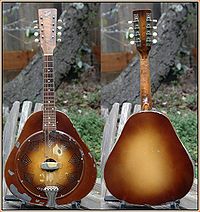National String Instrument Corporation
 | |
| Company type | Private |
|---|---|
| Industry | Musical instruments |
| Founded | 1927 in Los Angeles, California [1][2] |
| Founder | John Dopyera George Beauchamp |
| Defunct | 1932 (merged to Dobro) |
| Successor | National Reso-Phonic Guitar |
| Headquarters | , |
| Products | Resonator guitars |
The National String Instrument Corporation was a guitar company that formed to manufacture the first resonator guitars. National also produced resonator ukuleles and mandolins.
History
First years


The company was formed by John Dopyera, the luthier who invented the resonator, and George Beauchamp, a steel guitar player who had suggested to Dopyera the need for a guitar loud enough to play a melody over brass and other wind instruments.[3]
In 1927, National produced the first resonator instruments and sold under their National brand. They had metal bodies and a tricone resonator system, with three aluminium cones joined by a T-shaped aluminium spider. Wooden-bodied models soon followed, based on inexpensive plywood student guitar bodies supplied by Kay, Harmony, and other established instrument manufacturers.[3]
Dobro
In 1928, Dopyera left National, and with four of his brothers formed the Dobro Manufacturing Company to produce a competing single resonator design, with the resonator cone inverted. John Dopyera continued to hold stock in National. The Dobro design was both cheaper to produce and louder than the tricone.[3]
National soon introduced their own single resonator design, the biscuit, which Dopyera claimed to have designed before leaving, though the patent was registered by Beauchamp. National also continued to produce tricone designs, which some players preferred.
In their 1930 catalog, National list eight key associates, including Adolph Rickenbacker, George Beauchamp, Harry Watson, Paul Barth, and Jack Levy.[4]
In 1932, the Dopyera brothers secured a controlling interest in both National and Dobro, and merged the companies to form the National Dobro Corporation.
National Reso-Phonic Guitars
In 1989 a new company in California named National Reso-Phonic Guitars[5] began manufacturing reproductions of resonator instruments based on designs originated by John Dopyera.
Resonator guitar designs
The National brand and trademark are particularly associated with two of the three basic resonator designs:
- The tricone design with three resonator cones
- The biscuit design with a single cone
Terms such as National or National pattern are often used to distinguish these patterns from the Dobro design.
Notable artists
Some of the artists that used National guitars were:[2]
- Black Ace
- Scrapper Blackwell
- Bumble Bee Slim
- Bo Carter
- Ray Davies
- Reverend Gary Davis
- Blind Boy Fuller
- Arvella Gray
- Son House
- Mark Knopfler
- Babe Stovall
- Tampa Red
- Bukka White
- Chris Tapp
- Chris Whitley [6]
- Oscar "Buddy" Woods
- Dan Auerbach[7]
- Reverend J. Peyton of The Reverend Peyton's Big Damn Band
- Tinsley Ellis
See also
- Resonator guitar, particularly the history section.
- Dobro Manufacturing Company.
- National Reso-Phonic Guitars.
Further reading
- "The Earliest Days of the Electric Guitar" at Rickenbacker website
- Wheeler, Tom: The Guitar Book: A Handbook for Electric & Acoustic Guitarists (1978), Harpercollins - ISBN 0-06-014579-X
References
- ^ "National Guitars: American Tradition". Bobbrozman.com. Retrieved 2016-07-23.
- ^ a b "National Guitars". National Guitars. Archived from the original on 2014-10-08. Retrieved 2016-07-23.
{{cite web}}: Unknown parameter|deadurl=ignored (|url-status=suggested) (help) - ^ a b c "Early History of Rickenbacker". Rickenbacker.com. Retrieved 2016-07-23.
- ^ Tom Wheeler, The Guitar Book: A Handbook for Electric & Acoustic Guitarists. Harpercollins (1978). ISBN 0-06-014579-X, p. 153
- ^ "Business Search - Business Entities - Business Programs". Kepler.sos.ca.gov. Retrieved 2016-07-23.
- ^ ""Mustard": Chris Whitley's Iconic National Guitar | All Things Chris Whitley". Allthingschriswhitley.wordpress.com. Retrieved 2016-07-23.
- ^ http://guitarsnstuff.weebly.com/uploads/1/7/0/4/17044848/7430356.jpg?547

